
1
Welcome to Perth Zoo
| 
2
Kangaroos
| 
3
Feeding Time for Kangaroos
|
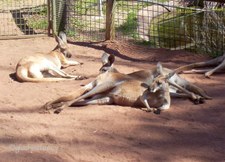
4
Kangaroos
| 
5
Australian Dingo
Australian Native Dog.
| 
6
Southern Hairy-nosed Wombat
|

7
Koala
| 
8
Bush Thick-knee
Burhinus grallarius
| 
9
Black-necked Stork
Ephippiorhynchus asiaticus. Often known as Jabiru and grows to 130 cm.
|

10
Eurasian Coot with Chick
Fulica atra
| 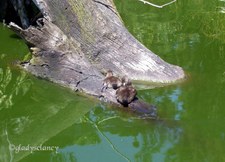
11
Ducks sunbaking on Log
| 
12
White Egret
|

13
Vervet (African Monkey)
| 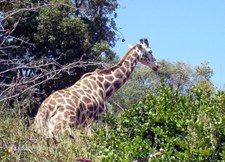
14
Rothschild's Giraffe
The Savannah's tallest animal.
| 
15
Rothschild's Giraffes
|

16
Grant's Zebra
| 
17
Cheetah in the Grass
The name cheetah comes from an Indian word meaning 'spotted one'.
| 
18
Sumatran Tiger
|

19
Slender-tailed Meerkats
| 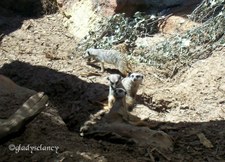
20
Slender-tailed Meerkats
| 
21
Australian Native Frangipani
(Hymenosporum Flavum). Many colourful species of plants can be seen in the well-maintained gardens at Perth Zoo.
|

22
Orange Clivia
| 
23
Wedding Bush (Ricinocarpos pinifolius)
| 
24
Clivia
|

25
Little Penguins
Eudyptula minor novaehollandiae
| 
26
Little Penguins swimming in Pool
| 
27
Black Swans and other Waterbirds
|

28
Brolga and other Waterbirds
| 
29
Brolga and Waterbirds
| 
30
Brolga Reflections
Grus rubicundus
|

31
Waterbirds
| 
32
Australian Pelicans
| 
33
Motorbike Frog
Litoria moorei
|
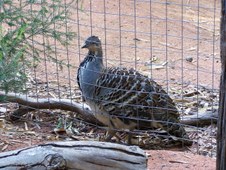
34
Malleefowl
Leipoa ocellata
| 
35
Numbat (Myrmecobius fasciatus)
Numbats (also known as Walpurti) are small marsupials, which feed almost solely on termites and consume about 20,000 per day. Because of this, they are also known as the Banded Anteater. When fully grown, they reach about 40 cms from nose to tail.
| 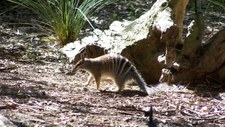
36
Numbat (Myrmecobius fasciatus) (Walpurti)
They inhabit woodlands in Western Australia which is the only state where they are found in the wild. To improve numbat numbers, they are bred in captivity at the Perth Zoo and released into selected locations.
|

37
Rock Wallaby
| 
38
Dingo resting on the Rock
| 
39
Dingo on the Rock
|

40
Australian Boab Tree
Adansonia gregorii
| 
41
Elephant plays with Blue Drum
| 
42
Elephants at Play
|

43
Elephants Playing
| 
44
Elephant close-up
| 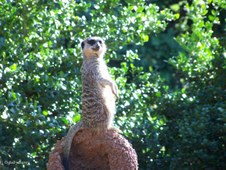
45
Slender-tailed Meerkat on 'Sentry Duty'
|

46
Here comes the Sumatran Tiger
| 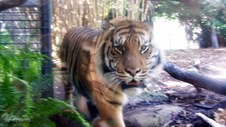
47
Face to Face with Sumatran Tiger
| 
48
Sumatran Tiger
Unfortunately, there are less than 500 Sumatran Tigers left in the wild.
|

49
Pygmy Marmoset (Callithrix pygmaea)
Found in the Upper Amazon basin, Pygmy Marmosets are the world’s smallest true monkeys.
| 
50
Pygmy Marmoset (Callithrix pygmaea)
The fur of this little monkey is a streaked, tawny brown on the back and drab yellow to white on the underside. Unlike most monkeys, the tails of pygmy marmosets are not prehensile - they cannot use their tails to swing from trees or grab objects.
| 
51
Ring-tailed Lemur (Lemur catta)
|

52
Cheetah
The cheetah is the world’s fastest land animal. Over short distances, it can sprint up to 70 miles per hour.
| 
53
Cheetah resting in the Grass
| 
54
Cheetah close-up
|

55
Cheetah close-up
| 
56
Southern White Rhinoceros
| 
57
Southern White Rhinoceros
|

58
Southern White Rhinoceros
| 
59
Rothschild's Giraffe
| 
60
Colourful Aloe Flowers in Zoo Gardens
|

61
Chamelon Dragon (Chelosania brunnea)
| 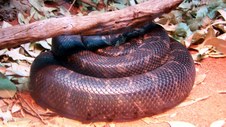
62
Carpet python (Morelia spilota imbricata)
Largest python found around the Perth hills area. Grows to approx 250cm.
| 
63
Pilbara Death Adder
(Acanthophis wellsi)
|

64
Dugite (Pseudonaja affinis)
Most common venomous snake found in the Perth area. This reptile belongs to the brown snake family.
| 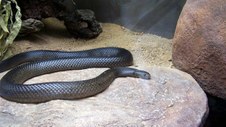
65
Dugite (Pseudonaja affinis)
It is very shy and will avoid contact with humans at all costs. If you are bitten, then seek medical attention immediately. Grows to approx 2 metres.
| 
66
Woma Python ( Aspidites ramsayi )
|

67
Olive Python (Morelia olivaceus)
| 
68
Perentie (Varanus giganteus)
The Perentie (Varanus giganteus) is the largest monitor lizard or goanna native to Australia.
| 
69
Perentie (Varanus giganteus)
The lizard can grow up to 2.5 metres (8 ft) in length although the average length is around 1.75-2 metres (5.5-6.5 ft) and weigh up to 15 kg (33 lb),maximum weight can be over 20 kg.
|

70
Perentie (Varanus giganteus)
The largest monitor lizard or goanna native to Australia.
| 
71
Australian Pelicans
| 
72
Double-wattled Cassowary
The Double-wattled Cassowary (Casuarius casuarius) is one of the largest birds in the world.
|

73
A Squirrel on the Pathway
| 
74
Radiated Tortoise (Geochelone radiata)
Much of the central habitat of the radiated tortoise is also the land of the Antandroy and Mahafaly people of Madagascar. In terms of traditional social values, both tribes respect the tortoise above all animals except cattle or zebu.
| 
75
Radiated Tortoise (Geochelone radiata)
'Tortoises bring the rains – God sends rains, not for the humans, who can look after themselves, but for the animals, like the tortoises, who need the rain and God’s help. When there are no more animals there will be no more rain'. (Mahafaly story)
|

76
Rothschild's Giraffes in widescreen
| 
77
Rothschild's Giraffe Family
| 
78
Rothschild's Giraffe Family
|

79
Rothschild's Giraffe 'Mum and Dad'
| 
80
Rothschild's Giraffe 'Mum and Dad'
| 
81
Rothschild's Giraffe 'Baby'
|

82
Grant's Zebra
The Grant's zebra is the smallest subspecies of the Plains Zebra.
| 
83
Grant's Zebra
| 
84
Grant's Zebra
|

85
Slender-tailed Meerkat
| 
86
Slender-tailed Meerkat
| 
87
Spotted Hyena (Crocuta crocuta)
Spotted Hyena (Crocuta crocuta) inhabits most of Africa.
|

88
Spotted Hyena (Crocuta crocuta)
The spotted hyena has the strongest jaws in the animal kingdom.
| 
89
Spotted Hyena (Crocuta crocuta)
Different from most other animals, female spotted hyenas are dominant over the males and outweigh them by about 3 pounds.
| 
90
Hamadryas Baboon (Papio hamadryas)
The Hamadryas Baboon was a sacred animal to the ancient Egyptians as the attendant of Thoth, and so, is also called the Sacred Baboon.
|

91
Hamadryas Baboon opening Cardboard Box
The Keeper had just thrown these Boxes and Pipes in for the Baboons.
| 
92
Hamadryas Baboon playing with Box
The Keeper hides Treats in Boxes and Pipes to provide stimulation and play for the animals.
| 
93
Hamadryas Baboons with Boxes and Pipes
|

94
Hamadryas Baboon (Papio hamadryas)
| 
95
Hamadryas Baboon playing with Water
| 
96
Hamadryas Baboon finding Treats in Pipe
|

97
Hamadryas Baboon finding Treats in Pipe
| 
98
Hamadryas Baboon finding Treats in Pipe
| 
99
African Painted Dogs
It is also called the African hunting dog, the Cape hunting dog, the spotted dog, or the painted wolf in English, Wildehond in Afrikaans, and Mbwa mwilu in Swahili.
|

100
African Painted Dog
The African wild dog has a pelage with an irregular pattern of black, yellow, and white, distinctive for each individual. The scientific name Lycaon pictus is derived from the Greek for 'painted wolf'.
| 
101
Asian Elephant
| 
102
Asian Elephant crawling in the Sand
On instruction from Keeper.
|
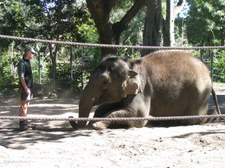
103
Keeper with Asian Elephant
The Keeper stimulates the Elephants by a regular program of exercises and tricks.
| 
104
Keeper rewards the Elephant
| 
105
A friendly pat from the Keeper
|

106
Elephant doing a Hand Stand
| 
107
Asian Elephant and Keeper
| 
108
Galapagos Tortoise
Fully grown adults can weigh over 300 kilograms (661 lb) and measure 1.2 meters (4 ft) long.
|

109
Galapagos Tortoise
The Galápagos tortoise (or Galápagos giant tortoise), is the largest living tortoise, native to seven islands of the Galápagos archipelago.
| 
110
Galapagos Tortoise
They are very long-lived with a life expectancy in the wild estimated to be over 150 years.
| 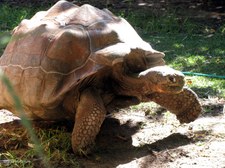
111
Galapagos Tortoise close-up
They have become one of the most symbolic animals of the fauna of the Galápagos Islands.
|

112
Galapagos Tortoise in a Hurry
| 
113
Sumatran Orang-utan with Baby
| 
114
Sumatran Orang-utan
Mother up high on the climbing tower.
|

115
Baby Sumatran Orang-utan
Climbing up the high tower.
| 
116
Baby Sumatran Orang-utan
Nearly to the top of the Tower.
| 
117
Baby Sumatran Orang-utan
Don't fall....
|

118
Baby Sumatran Orang-utan
Still hanging on ...
| 
119
Baby Sumatran Orang-utan
High on the Platform ....
| 
120
Sumatran Orang-utan
Baby now safe with Mother...
|

121
Sumatran Orang-utan
Mother and Baby exercising on the ropes...
| 
122
Otter drying on the Rocks
| 
123
Male Sun Bear
The sun bear (Helarctos malayanus), also known as the dog bear or honey bear, after its love of honey, is the smallest of the eight bear species.
|

124
Male Sun Bear
| 
125
Male Sun Bear
The Sun Bear is black with a golden crescent marking on its chest which, in ancient Eastern folklore, represents the sun.
| 
126
Female Sun Bear
Red Glow is a Heat Lamp in Cave.
|

127
Female Sun Bear finds Bag of Feed
Young Baby Bear was camouflaged at rear of yard.
| 
128
Dinner Time for Female Sun Bear
Young Baby stayed at rear of yard.
| 
129
Silvery Gibbon
|

130
Silvery Gibbon with small Baby
She put her leg across to prevent baby falling off platform..
| 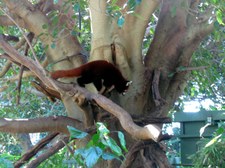
131
Nepalese Red Panda
The red and white colouring of the Nepalese Red Panda plays and important part in its survival. It provides protection by enabling the panda to camouflage with reddish moss and white lichen found in its natural habitat.
| 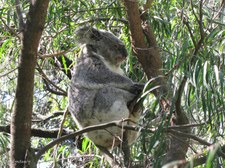
132
Koala
Active through the night and resting most of the day, the Koala spends much of its time eating eucalypt leaves.
|

133
Koala in the Gum Trees
| 
134
Southern Hairy-nosed Wombat
| 
135
Dingo (Canis lupus dingo)
Australian Native Dog.
|

136
Dingo (Canis lupus dingo)
Dingoes have pricked ears, bushy tails and a distinctive trotting gait. Their coats are typically ginger but some are sandy-yellow, red-yellow or occasionally black and tan. Most have white markings on their feet, tail tip and chest.
| 
137
Dingo Yawning...
Dingoes don’t bark, they howl. They have 3 different types of howls: moans, bark/howls and snuffs. Howling is used for long distance communications to attract pack members and repel rivals.
| 
138
Dingo Looking...
Although dingoes are often seen alone, many belong to socially interacted packs whose members meet every few days.
|

139
Dingo Listening...
Dingo life span is 8-10 years, they grow to 60 cm high and weigh up to 15 kg.
| 
140
Black-and-white Ruffed Lemur at Play
(Varecia variegata)
| 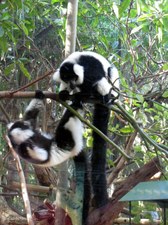
141
Black-and-white Ruffed Lemur at Play
(Varecia variegata)
|

142
Black-and-white Ruffed Lemur at Play
(Varecia variegata)
| 
143
Long Bushy Tail of Black-and-white Ruffed Lemur
(Varecia variegata)
| 
144
Black-and-white Ruffed Lemur (Varecia variegata)
|

145
Ring-tailed Lemur (Lemur catta)
| 
146
Splendid Tree Frog (Litoria splendida)
| 
147
Slender Tree Frog (Litoria adelaidensis)
|

148
Western Swamp Tortoise
(Pseudemydura umbrina). The Western Swamp Tortoise is one of Australia's most endangered reptiles. It has the smallest surviving population of any Australian reptile.
| 
149
Western Swamp Tortoise
(Pseudemydura umbrina). Western Swamp Tortoises are very small, growing up to 15 centimetres in shell length.
| 
150
Western Swamp Tortoise
(Pseudemydura umbrina). The Western Swamp Tortoise is unique, with an ancestry that dates back 15-20 million years.
|

151
Western Swamp Tortoise
(Pseudemydura umbrina). Restricted to only two wild populations, there are less than 200 endangered Western Swamp Tortoises left. These are found near Perth in Western Australia.
| 
152
Black-necked Stork
(Ephippiorhynchus asiaticus). Often known as Jabiru and grows to 130 cm.
| 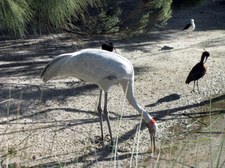
153
Brolga at water's edge
(Grus rubicundus).
|

154
Black-necked Stork often known as Jabiru
| 
155
Black Brittern in the Shadows
| 
156
Pied Cormorant and Black Brittern
|

157
IMG 3460
| 
158
Plumed Whistling-Duck
(Dendrocygna eytoni).
| 
159
Feather Detail of Plumed Whistling-Duck
|

160
Young Plumed Whistling-Duck
(Dendrocygna eytoni).
| 
161
Black-necked Stork often known as Jabiru
| 
162
Black-necked Stork often known as Jabiru
|

163
Striated Heron (Butorides striatus)
| 
164
Striated Heron (Butorides striatus)
| 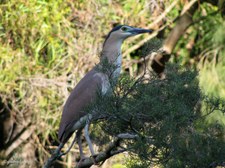
165
Striated Heron (Butorides striatus)
|

166
Black Cormorant
| 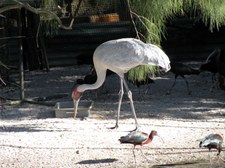
167
Brolga and other water birds
| 
168
White Egret
|

169
White Egret
| 
170
Brolga
(Grus rubicundus).
| 
171
Little Penguins
(Eudyptula minor novaehollandiae).
The smallest of all penguins.
|

172
Little Penguin
(Eudyptula minor novaehollandiae).
| 
173
Two Little Penguins
| 
174
Little Penguin
(Eudyptula minor novaehollandiae).
|

175
Bear Caves from the Past
First built in 1898, these caves were used to house not only bears but foxes, dingos and jackals as well. They are a relic from a time when zoos were simply places for collecting and displaying animals as spectacles.
| 
176
Bear Caves built in 1898
Since that time, the role of zoos has changed and animal wellbeing is of the highest importance. Today Perth Zoo's purpose is to conserve species and habitat and involve the community in conservation action.
| 
177
Bronze Monkey
Permanently resting on the seat near exit as visitors leave for home.
|

178
Ferry approaching Mends Street Jetty
| 
179
Perth Skyline across the Swan River
| 
180
Boarding Ferry at end of Day at Zoo
|